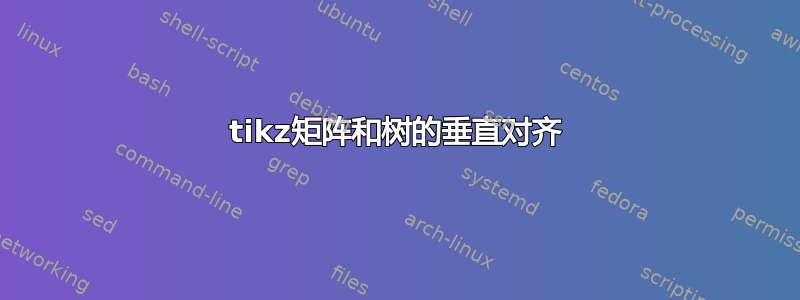
我想在同一个图形环境中将表格显示为 tikz 矩阵,旁边是 tikz 树。对于同一图形环境中有两棵树的情况,使用每个 tikzpicture 中的基线选项可以将两张图片对齐在顶部,但对于这种情况则不行!为什么会这样?
\documentclass{article}![enter image description here][1]
\usepackage{tikz}
\usetikzlibrary{matrix}
\usepackage{booktabs}
\begin{document}
\tikzset{align at top/.style={baseline=(current bounding box.north)}}
\begin{figure}
\centering
\begin{tikzpicture}[baseline]
\matrix (m) [matrix of nodes,
nodes={ minimum height=6mm, minimum width=2cm,align=center}
]{
\toprule
$CT$&freq\\ \midrule
$\{b,d,e\}$ &4\\
$\{c,e,f\}$ &3\\
$\{a,c\}$&4\\
$\{a,g\}$&4\\
$\{f\}$&4\\
$\{g\}$&4\\
\bottomrule \\
};
\end{tikzpicture}
\hspace{4ex}
\begin{tikzpicture}[baseline,
fp/.style={rectangle, draw, rounded corners=1mm,
text centered, anchor=north},
inact/.style={rectangle, draw=black!50, rounded corners=1mm,
text centered, anchor=north, text=black!50},
level 1/.style={sibling distance=1.9cm},
level distance=0.8cm, growth parent anchor=south,
transform shape]
\node [fp] (n){$\emptyset$}
child {[sibling distance=1.3cm]
node [fp] (a) {$a:2$}
child {
node [fp] (ac) {$c:1$}
}
child {
node [fp] (ab) {$b:1$}
}
}
child {[sibling distance=1.2cm]
node[fp] (c) {$c:1$}
child{
node[fp] (ce) {$e:1$}
child {
node[fp] (cef) {$f:1$}
}
}
}
child {
node[fp] (e) {$e:1$}
child {
node[fp] (eb) {$b:1$}
child {
node[fp] (ebd) {$d:1$}
}
}
};
\end{tikzpicture}
\caption{The encoding of a database (left table) and the induced tree representation of the database (right).}
\label{fig:tree}
\end{figure}
\end{document}

答案1
如果您添加baseline=(current bounding box.north)到两个tikzpicture环境中它就会起作用。
\documentclass{article}
\usepackage{tikz}
\usetikzlibrary{matrix}
\usepackage{booktabs}
\begin{document}
\tikzset{align at top/.style={baseline=(current bounding box.north)}}
\begin{figure}
\centering
\begin{tikzpicture}[baseline = (current bounding box.north)]
\matrix (m) [matrix of nodes,
nodes={ minimum height=6mm, minimum width=2cm,align=center}
]{
\toprule
$CT$&freq\\ \midrule
$\{b,d,e\}$ &4\\
$\{c,e,f\}$ &3\\
$\{a,c\}$&4\\
$\{a,g\}$&4\\
$\{f\}$&4\\
$\{g\}$&4\\
\bottomrule \\
};
\end{tikzpicture}
\hspace{4ex}
\begin{tikzpicture}[baseline=(current bounding box.north),
fp/.style={rectangle, draw, rounded corners=1mm,
text centered, anchor=north},
inact/.style={rectangle, draw=black!50, rounded corners=1mm,
text centered, anchor=north, text=black!50},
level 1/.style={sibling distance=1.9cm},
level distance=0.8cm, growth parent anchor=south,
transform shape]
\node [fp] (n){$\emptyset$}
child {[sibling distance=1.3cm]
node [fp] (a) {$a:2$}
child {
node [fp] (ac) {$c:1$}
}
child {
node [fp] (ab) {$b:1$}
}
}
child {[sibling distance=1.2cm]
node[fp] (c) {$c:1$}
child{
node[fp] (ce) {$e:1$}
child {
node[fp] (cef) {$f:1$}
}
}
}
child {
node[fp] (e) {$e:1$}
child {
node[fp] (eb) {$b:1$}
child {
node[fp] (ebd) {$d:1$}
}
}
};
\end{tikzpicture}
\caption{The encoding of a database (left table) and the induced tree representation of the database (right).}
\label{fig:tree}
\end{figure}
\end{document}



